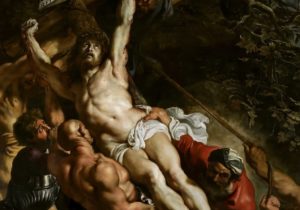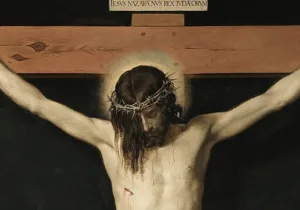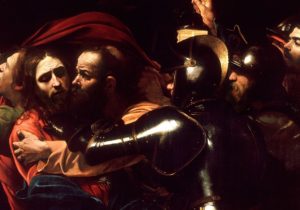The empty tomb of Easter Sunday answers the betrayal of Jesus on the cross with humanity’s completely restored understanding that God the Father, Son, and Holy Spirit’s remain one in essence, unity and purpose. The divine dissolution which seemed possible is now revealed to be untrue; the Triune God remains undivided and now triumphant, and in unending relationship with humanity. If Golgotha indicates the greatest expression of moral injury in history, then the mysterious but inhumanly supernatural resurrection of Jesus Christ from the dead is conversely the greatest expression of moral restoration in history. As Good Friday left us with the tension that humanity might have ultimately betrayed God, Easter Sunday resolves that tension with the assurance that this betrayal was only penultimate, and that not only did the Triune God remain indissoluble but also that same God turned humanity’s betrayal on its head. Indeed, God through the empty tomb existentially restores the rupture begun in Eden, fully reconciling humanity to Himself and restoring the possibility for each person to realize an eternal, salvific relationship with God that offers identity, meaning, and hope.
However, and analogous to the moral injury of the cross, the moral restoration of the tomb is iterative, coming in ever expanding, concentric revelation and effect. The greatest and first of these realized effects is, as previously mentioned, the persons and work of the Triune God in achieving the resurrection of Christ Jesus from the dead. Again, while the cross seemed to indicate that humanity’s betrayal of Jesus through both the people of Jerusalem and His disciples may have imperiled the Holy Trinity, the empty tomb testifies that what appeared to be this possibility was never so, let alone an existential reality. Rather and in a climactic example of martyrion, just was it was God the Father’s will for the Christ to suffer and die an atoning death on the cross, so it was always the Father’s plan for Jesus’ suffering and death to never be an end unto itself but rather a means to an end of the Christ’s triumphant resurrection. In the face of such a mystery, we can only join ours with the voices of saints militant and triumphant in acclaiming the truth that in this three days, Christ Jesus descended to the dead, extending the power of God to the lowest depth of hell. Thus, even there, the vilest demon of Hades must now know the ontological truth that the Son of God is alive to continue the salvific work of the Father, still more so as the Holy Spirit will now be the agent through which Christ Jesus returns to humanity, very much alive forevermore.
The second expression of moral restoration must, of needs, come next with the disciples. The previously faithless and frightened cohort of Jesus’ closest followers, who abandoned Him at not only His greatest hour of need but also at the climax of His messianic mission, now must become the first witnesses to His completed resurrection. Here, and perhaps now fearfully living in the wake of their filial abandonment prior to the cross, the women of Jesus’ earthly apostolic cohort become the first human witnesses of His new life, but then call both Peter and John to come view the empty tomb. Nonetheless, it falls to the eleven remaining disciples to begin the extension of the mysterious witness of Christ Jesus’ resurrection to the extent of the Roman empire. Moreover, it will be their testimony of that atoning death, resurrection and future ascension of Christ Jesus’ that will form the kerygmatic core of apostolic preaching to the world. Indeed, and in future partnership with both Paul and other missionaries, and in obedience to the outpouring of the Holy Spirit at Pentecost, those same apostles will further testify to the complete synchronicity of the Triune God working in perfect unity, essence, and purpose towards achieving God’s salvific plan for humanity and the redemption of creation. In short and in the greatest of ironies, the last earthly people to fail Jesus will be the first earthly people to witness the risen Christ to the world, thereby participating in the divine outworking of the Triune God and creating a model for the continuing task and purpose of the Church.
The third expression of moral restoration, of course, is to, in, and through the people of God. The Gospel writers take pains to note that there were certainly miraculous supernatural events that occurred across Jerusalem during the crucifixion which bore witness to the pre-resurrected Jesus as the Christ of God. However, post-resurrection, the Gospel writers take further pains to testify that it is to the people of God that Christ Jesus appears after the disciples to demonstrate His triumph over sin, death, and hell. Again, and in a mark of existential irony, these same earthly citizens who had just a few days hence called for a criminal’s death for Jesus of Nazareth become the next cohort to whom the risen Christ of God appears in power and glory. Beyond now any earthly misapprehensions of a messiah oriented towards countering Roman martial and political power, the resurrected Christ Jesus appears to His disciples and then God’s people to inaugurate a Kingdom that will historically subsume Rome and transcend all earthly human structures of power and governance for the remainder of time. In doing so, Christ foreshadows the power of God the Father indwelling God’s faithful people at Jerusalem during Pentecost to go beyond even the earthly limits of the apostles, extending the reach of the resurrected Triune God to now the full extent of earth.
Here, then, is a signal contribution from the Church, the people of God, to current secular understandings of moral injury. In that specific context, the scholarly and public discourse about the possibility for recovery from moral injury has been centered on an almost solely clinical and academic construct of post-traumatic growth. While not disdaining the possibility of the real efficacy of such a construct to guide healing modalities, the construct of post-traumatic growth remains mired in an assumption that moral injury, and thus healing from it, remains tethered only to one’s self. The Gospel narratives of the moral injury of the cross and the moral restoration of the tomb rest on a different assumption, that such injury and healing is never confined solely to one but always in relationship to another. Further, from it the Church can proclaim a deeper identity to this injury and healing by locating its own culpability and restoration only through Jesus the Christ. Additionally, the Church can faithfully proclaim that in an augmentation of its Christology, Jesus can further identify with those suffering from moral injury because He completely understands what it means to suffer both real and apparent betrayal by His people, His disciples, and even His Father. However, He also offers then in His resurrection a restoration of our understanding of the Trinity, and from this, an expanding and real existential restoration God’s relationship to His disciples, His people, and ultimately to the world. If the cross is the penultimate expression of moral injury on a relational level, the empty tomb is the ultimate expression of moral restoration on a similar relational level, but with ever expanding effects reaching across time and the second coming of the triumphant, returning Christ.






